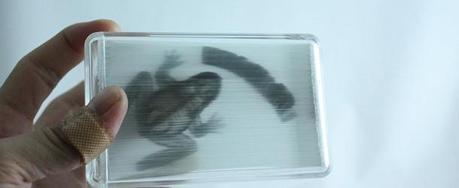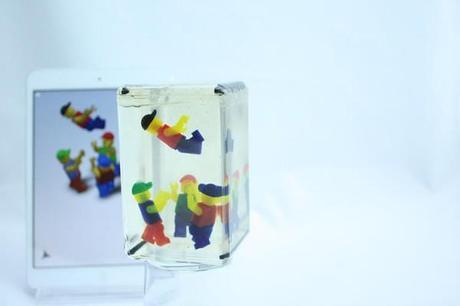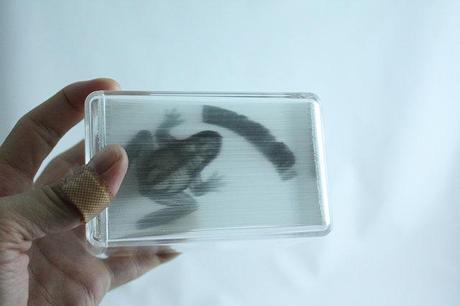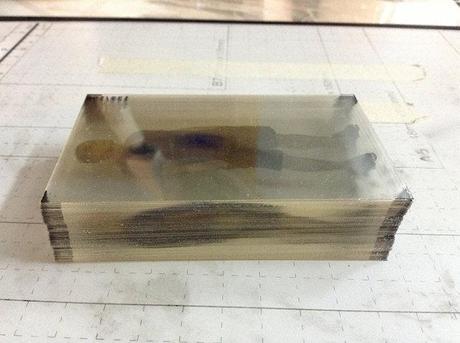





If you think 3-D printing will change the world, you probably imagine yourself printing objects that work, like organs and furniture. But today’s desktop printers are primarily churning out objects to look at, like self-portraits and plastic gnomes (Instagram gallery of MakerBot’s “thingiverse”) For these and other “purely visual” uses, Hong Kong inventor Shawn Frayne has created an alternative that is faster, simpler, and ingenious to the point of appearing magical.
“Purely visually, I think Looking Glass sort of crushes–it will crush–3-D object printing,” says Frayne.

To explain Looking Glass, Frayne says: “It’s hypervisual so it should explain itself,” he told me as he placed on the table an assortment of what appeared to be 3-D-printed objects suspended in clear plastic boxes: four lego men, a vase of flowers, a shark. “My pitch is this may look like a toy shark, but in fact there is nothing in here but for ink,” he said.
Ink, on 200 sheets of plastic inside a box he bought at Muji. The process by which this comes to impersonate a shark is what Frayne calls “volumetric printing.” It started with a 3-D design file made for traditional 3-D printing (in this case, by Peter Tan). But instead of creating each layer with extruded plastic, Looking Glass printed them in full color onto 0.3 mm-thick, clear lucite sheets using an inkjet, poster printer. “It’s using 2-D printers for 3-D printing,” says Frayne.
The stack alone creates a 3-D effect, but hampered by something called Fresnel reflection. Essentially, the clear sheets becomes murkier and murkier as the light refracts through the less-dense air between the sheets. A vase of flowers produced this way looks like it’s trapped in a thick cloud. “It’s the Han Solo carbonite thing,” says Frayne.
The insight that allowed Frayne and his colleagues at Haddock Inventions to solve this problem came from their years of work in a totally different sector: cleantech. Specifically, it came from solar panels, which often use an “index matching” substance to capture light more efficiently. “Basically it just means you put some sort of substance between two materials so light passes through more easily and have less reflections,” he explains. You replace the air with something that approximates the substance the air sits between. In this case, to mimic the refraction index of the acrylic lucite sheets they found a solution in silicon oil. “It’s a perfect match optically for acrylic,” says Frayne. ”You can think of it as if we melted the whole stack together.”

The result is a representation of a shark that I would swear was a physical shark–until I turned it 90 degrees. Seen from the side, you can see the sides of the sheets, with the ink visible only at angles. “It just disappears,” says Frayne.
That seeming weakness could be reduced with thinner sheets, but it may also be offset by other advantages. While 3-D printing a complicated object can take overnight, the whole process of printing, stacking, vacuuming out the air and pumping in the silicon oil takes Looking Glass less than an hour. “Eventually we can get it down to 30 minutes,” Frayne says.
And then there is the fact that volumetric prints can defy gravity. “If my hand is out here like this,” Frayne says, stretching his arm out as if reaching for something on a high shelf. “You can’t print it on a MakerBot, because the print will collapse; my arm will collapse. It doesn’t matter in this. It’s all just ink.”
This could make it possible to represent everything from Minecraft scenes to architectural diagrams to engineering and medical diagrams. The night before we spoke, Frayne had been emailing with a researcher who works on mouse brains, and was excited about the possibility not only of reproducing large-scale models from his scans, but also more far-out future uses, that could allow you to call up more detailed information by selecting the appropriate sheet on the Looking Glass. ”I sort of imagine this wall of reproduction specimens; You pull it out and scan it–’oh yeah that’s where it is’–and you put it back in the cubby,” he says. He also noted that one in four people who see the Looking Glass immediately imagine some kind of “volumetric television.”
For now, though, Frayne is focused on scaling up and accelerating the on-demand printing service (which currently has a three-week lag time). “I hope it becomes some sort of a new medium for people to imagine what they can bring from the virtual world into the real world.”
